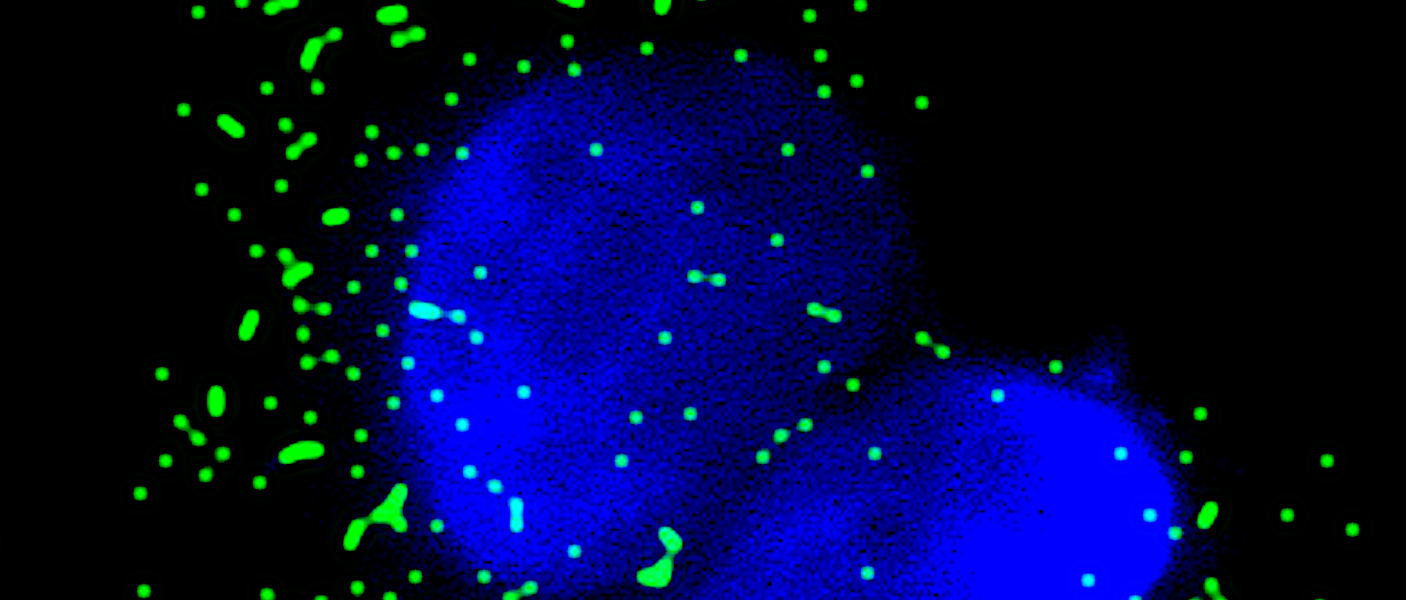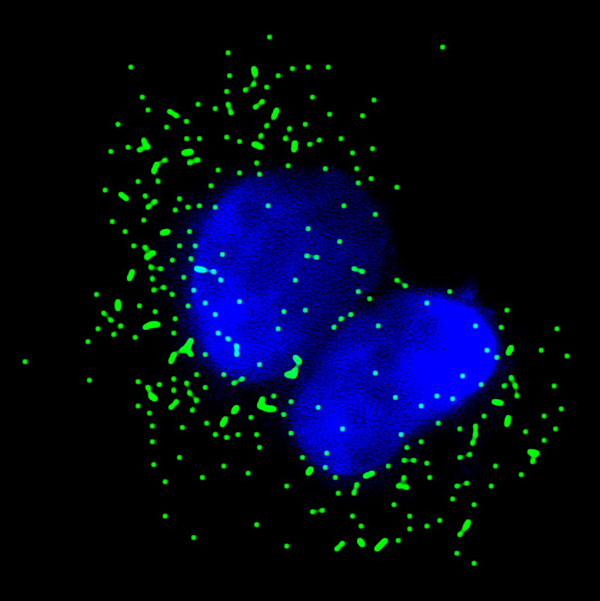

By Nicole Fawcett | labblog.uofmhealth.org | February 7, 2019
 smFISH image of HEK293T cells stained for DAPI (blue, nucleus) and CDR1AS (green, circRNA transcript) / Sethu Pitchiaya, PhD.
smFISH image of HEK293T cells stained for DAPI (blue, nucleus) and CDR1AS (green, circRNA transcript) / Sethu Pitchiaya, PhD.
As new technology allows researchers to plunge deeper into the genome and exome, a new class of RNA called circular RNA or circRNA, may play an intriguing role.
Researchers at the University of Michigan Rogel Cancer Center have cataloged circRNA in multiple cancers and conducted initial research that suggests these stable structures could serve as cancer biomarkers in blood or urine.
CircRNA are a type of non-coding RNA that forms into a closed circular structure rather than a linear structure. New RNA sequencing methods have brought these to light, and little is known about why or how they function. But their stable structure makes them ideal candidates for developing cancer biomarkers.
The study, authored by Josh N. Vo, Marcin Cieslik, Yajia Zhang, Sudhanshu Shukla, Lanbo Xiao, Yuping Zhang, Yi-Mi Wu, Saravana M. Dhanasekaran, Carl G. Engelke, Xuhong Cao, Dan R. Robinson, Alexey I. Nesvizhskii, and Arul Chinnaiyan and published in Cell, identifies a compendium of circRNA in cancer, creating a database for future study.
“I’m most excited about the potential of circular RNAs as noninvasive biomarkers. Because of their stability, we might be able to detect these in the blood or urine of cancer patients. This could be useful for diagnosis or prognosis of cancer,” says Arul M. Chinnaiyan, MD, PhD, director of the Michigan Center for Translational Pathology and S.P. Hicks Professor of Pathology at Michigan Medicine.
 Chinnaiyan
Chinnaiyan
Researchers identified circRNA from more than 800 tumor samples collected as part of the MiONCOSEQ program. They demonstrated that the capture RNA sequencing developed for MiONCOSEQ was more robust in detecting circRNA than existing methods.
“The capture approach can be limited because it’s based on the probes we used to capture RNAs. But the whole exome capture approach makes it significant. We capture a large swath of RNA that way. That’s why we were able to nominate so many circRNAs that were not known before,” Chinnaiyan says.
The technique requires only a small amount of total RNA to be able to identify circRNA. This means it could be detected in places where RNA is diluted, such as blood or urine.
In addition, the team identified several circRNAs that were found in prostate cancer tissue. By evaluating circRNA from prostate cancer cells, they found them to be more stable than linear RNA.
“We were able to show that these circRNAs exist in urine and that those coming from prostate cancer can be detected. Our future studies will explore these circRNAs as urine- or blood-based cancer biomarkers,” Chinnaiyan says.
The researchers turned their findings into a database called MiOncoCirc, cataloging the reported circRNAs from tumor samples. This resource is available to other researchers to aid in developing new cancer biomarkers.
 ON THE COVER
ON THE COVER
Breast team reviewing a patient's slide. (From left to right) Ghassan Allo, Fellow; Laura Walters, Clinical Lecturer; Celina Kleer, Professor. See Article 2014Department Chair |

newsletter
INSIDE PATHOLOGYAbout Our NewsletterInside Pathology is an newsletter published by the Chairman's Office to bring news and updates from inside the department's research and to become familiar with those leading it. It is our hope that those who read it will enjoy hearing about those new and familiar, and perhaps help in furthering our research. CONTENTS
|
 ON THE COVER
ON THE COVER
Autopsy Technician draws blood while working in the Wayne County morgue. See Article 2016Department Chair |

newsletter
INSIDE PATHOLOGYAbout Our NewsletterInside Pathology is an newsletter published by the Chairman's Office to bring news and updates from inside the department's research and to become familiar with those leading it. It is our hope that those who read it will enjoy hearing about those new and familiar, and perhaps help in furthering our research. CONTENTS
|
 ON THE COVER
ON THE COVER
Dr. Sriram Venneti, MD, PhD and Postdoctoral Fellow, Chan Chung, PhD investigate pediatric brain cancer. See Article 2017Department Chair |

newsletter
INSIDE PATHOLOGYAbout Our NewsletterInside Pathology is an newsletter published by the Chairman's Office to bring news and updates from inside the department's research and to become familiar with those leading it. It is our hope that those who read it will enjoy hearing about those new and familiar, and perhaps help in furthering our research. CONTENTS
|
 ON THE COVER
ON THE COVER
Director of the Neuropathology Fellowship, Dr. Sandra Camelo-Piragua serves on the Patient and Family Advisory Council. 2018Department Chair |

newsletter
INSIDE PATHOLOGYAbout Our NewsletterInside Pathology is an newsletter published by the Chairman's Office to bring news and updates from inside the department's research and to become familiar with those leading it. It is our hope that those who read it will enjoy hearing about those new and familiar, and perhaps help in furthering our research. CONTENTS
|
 ON THE COVER
ON THE COVER
Residents Ashley Bradt (left) and William Perry work at a multi-headed scope in our new facility. 2019Department Chair |

newsletter
INSIDE PATHOLOGYAbout Our NewsletterInside Pathology is an newsletter published by the Chairman's Office to bring news and updates from inside the department's research and to become familiar with those leading it. It is our hope that those who read it will enjoy hearing about those new and familiar, and perhaps help in furthering our research. CONTENTS
|
 ON THE COVER
ON THE COVER
Dr. Kristine Konopka (right) instructing residents while using a multi-headed microscope. 2020Department Chair |

newsletter
INSIDE PATHOLOGYAbout Our NewsletterInside Pathology is an newsletter published by the Chairman's Office to bring news and updates from inside the department's research and to become familiar with those leading it. It is our hope that those who read it will enjoy hearing about those new and familiar, and perhaps help in furthering our research. CONTENTS
|
 ON THE COVER
ON THE COVER
Patient specimens poised for COVID-19 PCR testing. 2021Department Chair |

newsletter
INSIDE PATHOLOGYAbout Our NewsletterInside Pathology is an newsletter published by the Chairman's Office to bring news and updates from inside the department's research and to become familiar with those leading it. It is our hope that those who read it will enjoy hearing about those new and familiar, and perhaps help in furthering our research. CONTENTS
|
 ON THE COVER
ON THE COVER
Dr. Pantanowitz demonstrates using machine learning in analyzing slides. 2022Department Chair |

newsletter
INSIDE PATHOLOGYAbout Our NewsletterInside Pathology is an newsletter published by the Chairman's Office to bring news and updates from inside the department's research and to become familiar with those leading it. It is our hope that those who read it will enjoy hearing about those new and familiar, and perhaps help in furthering our research. CONTENTS
|
 ON THE COVER
ON THE COVER
(Left to Right) Drs. Angela Wu, Laura Lamps, and Maria Westerhoff. 2023Department Chair |

newsletter
INSIDE PATHOLOGYAbout Our NewsletterInside Pathology is an newsletter published by the Chairman's Office to bring news and updates from inside the department's research and to become familiar with those leading it. It is our hope that those who read it will enjoy hearing about those new and familiar, and perhaps help in furthering our research. CONTENTS
|
 ON THE COVER
ON THE COVER
Illustration representing the various machines and processing used within our labs. 2024Department Chair |

newsletter
INSIDE PATHOLOGYAbout Our NewsletterInside Pathology is an newsletter published by the Chairman's Office to bring news and updates from inside the department's research and to become familiar with those leading it. It is our hope that those who read it will enjoy hearing about those new and familiar, and perhaps help in furthering our research. CONTENTS
|

MLabs, established in 1985, functions as a portal to provide pathologists, hospitals. and other reference laboratories access to the faculty, staff and laboratories of the University of Michigan Health System’s Department of Pathology. MLabs is a recognized leader for advanced molecular diagnostic testing, helpful consultants and exceptional customer service.